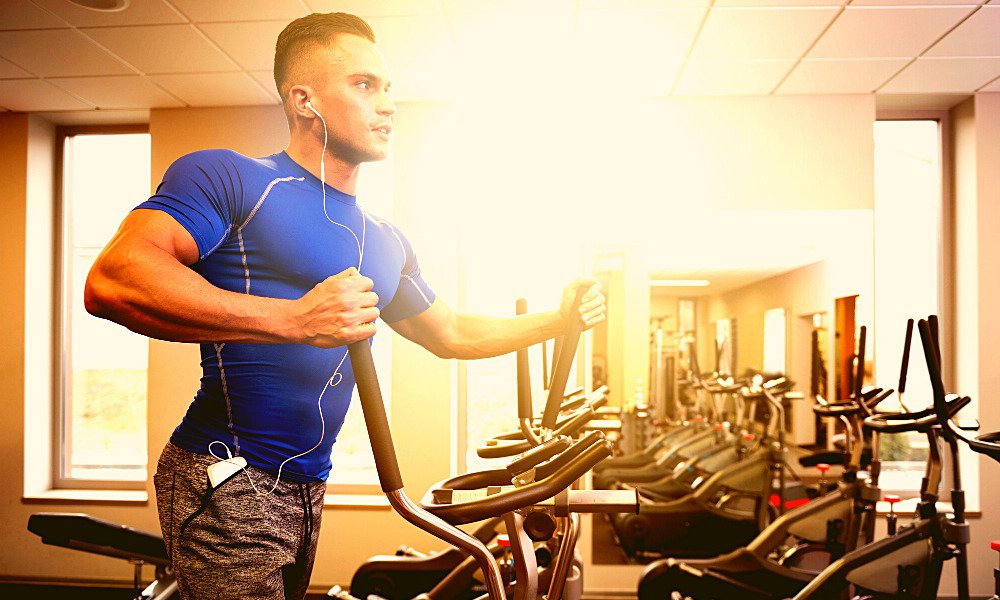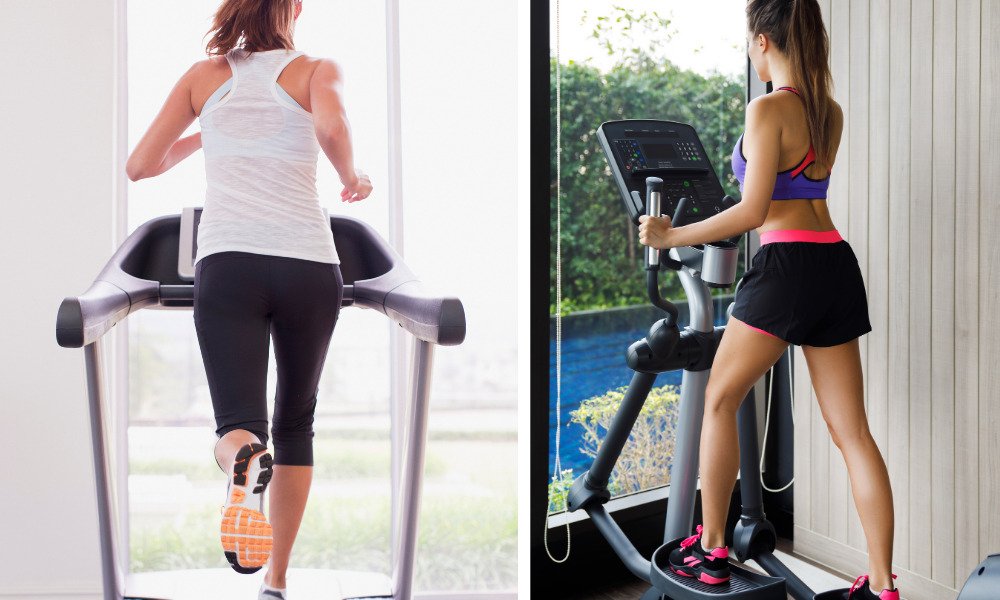What burns more calories, an Elliptical or a Treadmill? It depends on which machine will motivate you the most and push you to the highest level of exertion. Harvard Health Publishing notes that the average adult needs around 150 minutes of moderate physical activity per week. You can achieve this goal in various ways by calculating how frequently you want to work out each day, as well as how long you will work out each time. For instance, you can exercise for 15 minutes twice per day, for 10 minutes 3 times per day, etc.
Likewise, exercise equipment can help us burn calories and lose weight. Many people ask themselves what piece of equipment will help them lose the most weight by burning the most calories. Two popular choices at the gym, or even at home, are treadmills and ellipticals.
A treadmill is an exercise machine designed for users to walk or run at varying degrees of intensity while staying in the same place. Treadmills are one of the most popular pieces of exercise equipment and are sold more often than any other form of exercise equipment. It is designed so that users can experience a cardiovascular workout.
In comparison, an elliptical is a piece of exercise equipment people use to “stair climb, walk, or run without causing excessive pressure to the joints.” It is also designed for cardiovascular workouts, but with no impact. It is often preferred by people who want to work out without exacerbating a minor injury or strain their muscles.
So, what burns more calories, an elliptical or a treadmill? To put it briefly, a treadmill will generally burn more calories, however, there are several things to remember when using a treadmill that will let you burn sufficient calories for fat loss. Furthermore, an elliptical may be a better option for you if you prefer a non-impact workout.
Read More:
- Best Elliptical Machines Under $500: Top 5 Options Reviewed
- How to Choose a Treadmill for Home Use
- Smith Machine vs Squat Rack vs Power Rack
- Can I Walk on a Treadmill While Pregnant?
- Bowflex Xceed Home Gym Reviews
How Many Calories Can You Burn on a Treadmill?

Generally speaking, using a treadmill will cause you to burn more calories than using an elliptical. The main reason for this is because the act of lifting your feet repeatedly burns more calories than exercising on an elliptical with your feet planted on the pedals. Lifting your feet while running on a treadmill demands more of your body’s energy.
A treadmill also “mimics the natural movement of running outside,” and is the more “straightforward” option out of the two. Runners World states that using a treadmill will burn about double the amount of calories as an elliptical. They state that using a 150-pound person using a treadmill properly can burn about 680 calories by running for 30 minutes, and the same person would only burn about half of that amount using an elliptical for the same amount of time.
That being said, there are a few important factors to remember if you want to use a treadmill to burn the most calories possible. First, the amount of calories you burn on a treadmill depends on the incline of the treadmill. If the treadmill is completely flat to the ground, you will not burn as many calories as you would when the treadmill has an incline.
For example, a woman weighing 150 pounds could burn 300 calories on a treadmill if she runs at 10 miles per hour with no incline, which can drastically increase when adding an incline. If she increases the incline percentage, to the recommended amount of 1 or 2 percent each time, she can burn a lot more calories running at the same speed.
If your goal is to use exercise equipment that burns the most calories, you have to use it properly. Using a treadmill without the incline can be compared to running down a hill. You won’t work up a sweat, your heart rate won’t increase enough, and you won’t feel like your body is exerting energy.
Another way to burn enough calories by playing with the incline increase is to abide by a certain routine every time you step on the treadmill. Healthline outlines a routine that will maximize calorie burning and fat loss. First, you should start with the treadmill being completely flat and walk at a pace of 2 miles per hour for 5 minutes.
Next, you should increase the incline by 1 percent. At this point, you can start jogging at 4 to 6 miles per hour for 1 minute. From this point onward, you should increase the treadmill’s incline by 1 percent every minute until you reach an 8 percent incline. Each time you increase the incline, jog for about 1 minute at 4 to 6 miles per hour.
You should also avoid using the handrail on a treadmill if your goal is to burn enough calories to lose weight. Essentially, the railing is there to help you get situated on the treadmill and to help you step off. If you use it while working out, your body won’t be exerting enough energy and your heart rate won’t be pumping, both signs that you’re burning calories, and you may also experience neck pain after your workout.
Read More:
- Best Punching Bag for Apartment Home Gyms
- Best Ab Machines at Home: Top 5 Most Ripped Review
- 5 Best Weight Benches for Small Spaces
- 5 Best Home Spin Bike
- 5 Best Workout Bench
How Many Calories Can You Burn Using an Elliptical?

An elliptical won’t burn as many calories as a treadmill as the latter allows for more of a cardio workout. For instance, someone weighing 150 pounds can burn around 330 calories riding an elliptical for 30 minutes. In comparison, a 125-pound person can burn close to 500 calories on a treadmill running at 10 miles per hour.
That being said, you can still burn calories using an elliptical and it can be the more suitable option in some scenarios. A treadmill can cause more strain to your leg muscles and feet, as well as your back and knees, while an elliptical doesn’t cause muscle strain after a workout.
An elliptical may also be the better option for you if your main concern isn’t just burning calories. For instance, an elliptical may be the better choice if you would like to work out both your arms and legs. If this sounds like you, make sure you choose an elliptical with upper body handles or poles, as not all of them are equipped with these. Read More: Top 5 Best Elliptical Under 1000
If you are recovering from a minor injury and need to avoid running for a while, but still want to burn calories and stay fit, an elliptical may be the better option as well. It is considered low impact, so if you have a mild knee, foot, or leg injury that hasn’t 100% recovered yet, you should opt for an elliptical instead of a treadmill. That being said, Podium Runner notes that an elliptical can irritate certain injuries, such as “stress fractures, Achilles injuries, and IT band issues.”
If you choose to use an elliptical over a treadmill to burn calories, you should remember a few things so you can burn as many as possible. First, you should focus on exerting as much energy as possible using just your legs. Your leg muscles are larger than your arm muscles, and larger muscles burn more calories than smaller muscles.
As we’ve mentioned, some ellipticals come with handles you can use for exercising your arm muscles. If you’re capable of working out your arms and legs at the same time, without reducing the intensity of your leg workout, you can maximize the number of calories you’re burning by focusing on both.
When using an elliptical instead of a treadmill, you should also pay special attention to your heart rate. Your heart rate should be at a certain level to successfully burn fat, which is about 70% of your maximum heart rate. Healthline notes that to calculate your maximum heart rate, you need to subtract your age from the number 220.
For instance, a 30-year-old woman would have a maximum heart rate of 190, with 70% of 190 being her fat-burning heart rate, or 133. This means that at 133 beats per minute, a 30-year-old woman can burn the desired amount of calories by using an elliptical. You can calculate your heart rate by pressing two fingers against your wrist and counting the beats in 15 seconds, then multiplying by 4.
Similar to the treadmill routine we discussed earlier where the user increases the incline every 5 minutes, you can also use an elliptical to practice high-intensity interval training, or HIIT. High-intensity interval training involves a “short burst” of high-intensity exercise, followed by brief moments of rest.
Since the elliptical is known to burn fewer calories than a treadmill, you should incorporate HIIT into your workout routine if you do choose to use an elliptical. It will increase your metabolic rate, allowing you to burn more calories. HIIT is also designed so that you continue to burn calories while you are resting.
To achieve high-intensity interval training on an elliptical, Top Fitness Magazine states you should start slowly by warming up for 3 minutes. Afterward, you should increase the resistance or incline and work out intensely for about 25 seconds. Next, you should rest or bring the resistance down to an easy level for 60-90 seconds, then repeat this routine 10 times.
Conclusion

What burns more calories, an Elliptical or a Treadmill? When comparing a treadmill to an elliptical, there are many important factors to consider. In broad terms, a treadmill does burn more calories as it resembles the most “natural” workout, which is running outside. While ellipticals do provide a calorie-burning cardiovascular workout, you generally exert more energy by running on a treadmill by repeatedly lifting your feet.
That being said, a treadmill burns more calories when there is an incline, and without using an incline you likely won’t burn the number of calories you want to. Additionally, an elliptical may be the preferred choice for people who want to work out their arms and legs simultaneously, and for those who want to stay fit yet are recovering from a minor injury.
It is also important to understand that how many calories you burn doesn’t just depend on the equipment, it depends on how much energy you’re exerting. For instance, walking on a treadmill with no incline will not burn as many calories as working out on an elliptical with high intensity. However, a treadmill trumps an elliptical when both are used at a high-intensity level.
Read More:
